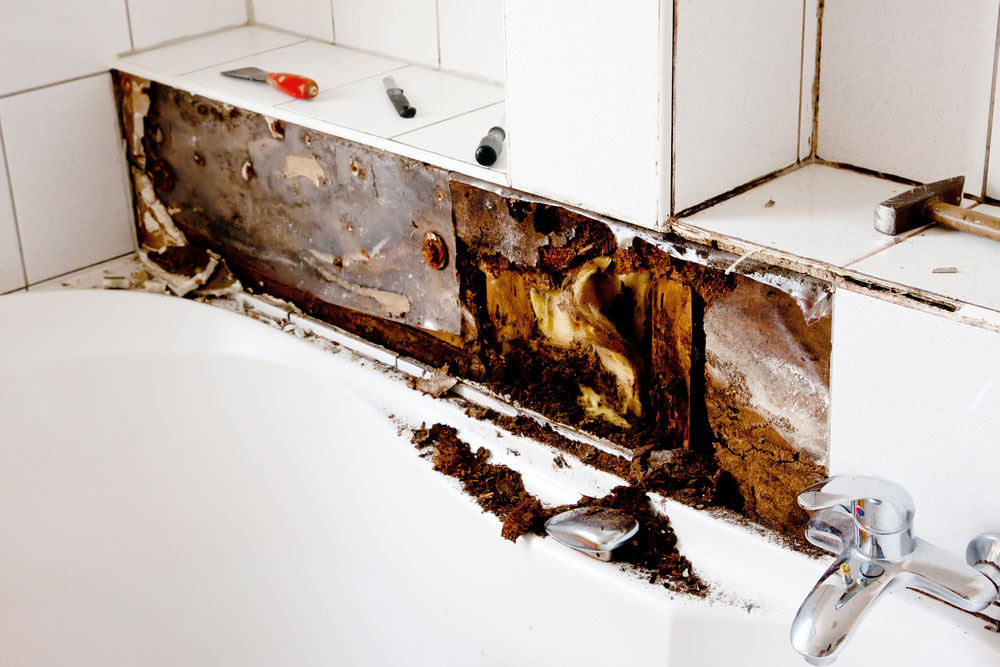What are your thoughts regarding Looking for Signs of Water Damage in the Bathroom?

The restroom is very susceptible for moist buildup as well as potential water damages because of the frequent use water in it. This short article provides easy inspection methods to help detecting water damages threats.
The constant use water in the restroom makes it incredibly vulnerable for wet build-up as well as potential water damages. By examining it frequently, you can reduce water relevant damages.
The following collection of examinations is simple to perform as well as should be done as soon as in every 3 months in order to maintain your restroom in good shape and to stop possible water damages brought on by the bath tub, the shower, pipeline joints as well as plumbing, sinks, cupboards, as well as the bathroom
Do not overlook carrying out these assessments as well as be extensive while doing them. Keep in mind that these easy inspections can conserve you a lot of cash by supplying early indicators for water damage
Sinks and Cabinets
Sinks and cupboards are subjected to wetness as well as humidity daily and are commonly neglected. Evaluate on a regular basis under the sink as well as on the countertop above it. Repair any kind of drip in the catch as it may suggest drainpipe issues. Take a look around the sink, slow draining pipes may indicate a blocked drain. Change sink seals if they are fractured or loosened.
Tub as well as Shower
The shower as well as bath tub require special focus and upkeep. Inspect the tiles and also change if cracked. Make sure that there is no missing cement in between the ceramic tiles. Evaluate as well as replace split caulking at joints where the walls fulfill the flooring or the tub. Blocked drains and also pipelines issues will certainly stop the bathtub from drying out as well as may show major issues under the bath tub. Talk to a professional quickly to avoid architectural damages. Pay attention to stainings or soft areas around the bath tub walls as they might suggest an inner leakage.
Plumbing
Signs for water damages are hard to identify considering that many pipelines are set up inside the walls.
Pay unique attention to floor covering and also wall surfaces moisture and also stains as they might indicate an unseen plumbing issue. Examine wetness levels in adjacent rooms too.
The Toilet
The toilet is an at risk water junction. Examine the water lines as well as look for leaks around the toilet seat, in the pipe, and under the water storage tank. If you detect any kind of signs of dampness on the floor around the bathroom, check for leaks in the toilet edge and also tank seals.
Know that hanging toilet bowl antiperspirants increases the opportunities for clogs.
Water Damage Signs In The Bathroom To Avoid Cleanup
Musty smell
This is one of the easiest signs to catch because musty smells are so odorous. The damp, earthy, moldy smell should be a big red flag. The smell will develop when moisture gets trapped in surfaces, and begins to facilitate mold growth. Leaking pipes under cabinets, inside walls, and behind shower fixtures will cause moisture to stay trapped and not dry, which will lead to mold growth and spread. As soon as you notice any musty smells in your bathroom, have it checked for hidden water damage and cleanup signs.
Visible mold
If the smell isn’t there to give it away, sometimes you will actually see mold growth. Finding mold in your bathroom is a serious problem, because mold is very harmful to your health. By the time mold growth is visible, it also means that water damage has already occurred and been present for some time. The only way the mold problem can be resolved is to find the source of the moisture and get it stopped. To safely and adequately remove mold, you need to have professionals handle the remediation. Do not waste any time in getting mold problems addressed, fixed, and sanitized so that you can protect you and your family from the many respiratory symptoms caused by mold exposure.
Damaged floors
Bathroom floors should be able to withstand some exposure to water while still remaining in good condition. However, when excess exposure or water leaks occur, they will begin to damage even the most water-resistant flooring. If you notice any cracking, bubbling, staining, or warping on your bathroom floors, there is probably a water leak somewhere causing the distortion. If you notice areas of the floor have become softer, or even have a spongy feeling, there is probably damage to the subfloor. Subflooring is typically made up of plywood. When plywood is exposed to water or moisture, it will absorb it. Once it has become saturated, the weight of the excess water will cause the wood to swell and soften. Check the floors in your bathroom frequently to catch any of these sings before they lead to damaged subflooring.
Changes on walls
When water leaks behind walls, it will cause changes in the drywall. Peeling plaster, blistering paint, and soggy wallpaper are all good indicators that excess water is building up behind the wall. Water leaking behind drywall will cause it to swell and be soft to the tough. If you start to notice gaps along the trim of your walls, or where tile meets the wall, it could also be a strong indicator that there is a leak behind the wall. Any changes, distortion, or damage on the walls should be evaluated as soon as you notice it to prevent further water damage and cleanup.

Hopefully you enjoyed reading our topic about How to Fix a Water Damage Bathroom. Thanks for taking time to browse our posting. Please take a moment to promote this content if you appreciated it. Thank you so much for your time spent reading it.
Services